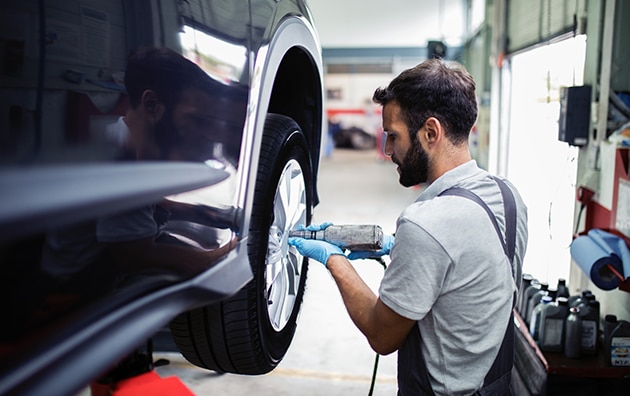Safety tips for tire changes to avoid flying tires


Improper tire changes can lead to runaway tires while driving, and a possible accident from a flying tire. Ontario’s Ministry of Transportation reported nearly 140 of such incidents in 2018 and estimates the total across all provinces, could be in excess of 1,000 annually.1 With a few safety tips and following the correct installation procedures, you can keep yourself, and others, safe from flying tires.
Why Change Your Tires?
It is especially important to pay attention to the risk of flying tires as you change from winter snow tires to all-season tires and back, typically in November and April.
Canadian winters are cold, with temperatures averaging -5°C.2 With all-season tires losing their grip around 7°C, winter tires are a great way to stay safe on the road in winter, even if snow isn’t in the forecast.3 Several provinces now require seasonal tire changes, making installation even more critical as more drivers adhere to guidelines.4
A major risk when changing tires are flying tires.
What is a Flying Tire?
Flying tires occur when a wheel becomes separated from a car and, rolls, bounces and careens through the air potentially striking other vehicles, causing accidents.
Why do Flying Tires Happen?
Wheel separations can happen after tire changes or brake work and are often the result of poor maintenance, the improper tightening of wheel fasteners, defective parts, or the lack of a second tightening a few weeks after an installation.5
What to Know When Changing Tires
While some people choose to get their tires changed by a professional, many choose to do it themselves. If you prefer to change your own, be sure to follow these seven tips for tire safety.
- Consult your vehicle’s manual for important specifications before you begin
- Ensure you have the proper tools including a service jack, safety stands, lug wrench or sockets, a breaker bar, a torque-wrench and a compressor to inflate the tires. Find a safe place to begin the installation.
- When installing winter tires, be careful to not mix them. Having the same type, size, speed rating and load index are necessary for the best performance. All four tires should be part of a set, and the tires should be mounted on dedicated wheels, reducing the risk of damage from mounting and dismounting multiple times.6
- As you move back to all-season tires, it is recommended to put the tires with the deepest tread on the rear of the vehicle.
- Take the time to inspect rims, wheel hubs and fasteners for damage and clean off wheels and hubs before positioning the wheel on the hub.
- After installing fasteners, tighten in stages, alternating from side to side until the manufacturer-recommended torque has been reached.
- Be sure to perform a torque check again, using a torque wrench, after the vehicle has been driven the distance recommended by the vehicle manufacturer, usually about 100 kilometres.7
Should You Have Your Tires Professionally Changed?
If you are unsure of the steps or do not have access to the right tools, you might consider paying for a professional install. If you are looking for convenience, some installers even come to your home or workplace and may store the alternate tires for you until you are ready to change them again.
Changing your auto tires between seasons is a common practice, but there are dangers involved, if not done properly. Following best practices helps keep your car, and your tires, safely on the road.
To learn more about Travelers car insurance or ways to stay safe on the roads check out our Prepare and Prevent resources. Contact your local independent broker to make sure that you have the coverage you need.
Sources
1 https://ottawacitizen.com/news/local-news/anatomy-of-a-highway-tragedy-two-years-later-fatal-wheel-separation-results-in-small-fines-few-answers
2 https://www.cbc.ca/wildcanadianyear/m_blog/ten-strange-facts-about-canadas-climate#:~:text=Canada%20is%20(really)%20cold.,daily%20temperature%20of%20%2D5.6C.
3 https://saaq.gouv.qc.ca/en/road-safety/modes-transportation/automobile/maintenance-safety/winter-preparation.
4 https://saaq.gouv.qc.ca/en/road-safety/modes-transportation/automobile/maintenance-safety/winter-preparation
5 https://ottawacitizen.com/news/local-news/dont-forget-to-retorque-lug-nuts-after-putting-on-winter-tires-opp-warn-after-highway-7-crash
6 https://www.wheels.ca/guides/how-to-change-your-tires-from-summers-to-winters
7 https://www.cbc.ca/news/canada/new-brunswick/tires-mechanics-garage-1.3558223